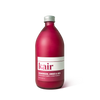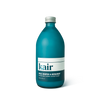Our ultimate guide to fabric conditioner
Fabric conditioner is a laundry staple: it conditions and protects clothing fibres, making them feel soft, supple and silky-smooth wear after wear. If you’re wondering why and how to use fabric conditioner - what it does, where it goes - then this is the guide for you.
What is fabric conditioner, and why use it?
Fabric conditioner is a kind of after-care for your clothes: it coats them with a light film which helps retain their shape and colour and make them last longer than if you were to go without. And to be clear from the very outset: fabric conditioner is the same as fabric softener, but it’s not detergent. As hair conditioner conditions your hair, fabric conditioner enhances the feel and manageability of your clothes. It makes them soft and silky (which is particularly welcome if you have very sensitive skin and/or live in a hard water area), as well as wrinkle and static-free by reducing friction between the fibres.
Which kind of fabric conditioner should you use?
Many fabric softeners can be hard on certain materials (microfibre and specialist fibres like wicking, as well as flameproof, water-resistant and synthetic items), degrading both the fibres and colour. But that’s not to say you should never use fabric softener on clothes - simply investigate the ingredients. Avoid anything containing chemical dyes and optical brighteners, and instead opt for something which will gently soften and protect the natural fibres. We recommend our eco-friendly refillable Signature Fabric Conditioner, which is plant-based and guaranteed to keep your clothes both soft and damage-free.

What kind of clothes and materials benefit from fabric conditioner?
Fabric softener works wonders on most clothing fibres, but we recommend avoiding using it on microfibre cloths and towels as well as sportswear. Fabric softener creates a thin, protective layer over each fibre, which can reduce a material’s absorbency, making these performance fabrics less effective (especially through repeated use or overdosing). Fabric softener can likewise interfere with the breathability of performance fabrics and sportswear by breaking down their special moisture-wicking properties. Sweat-wicking properties are important - without them, the sweat would saturate, and remain trapped within the inner layer of the garment (hardly ideal if you’ve just splashed out on premium, specialist performance wear). For the same reason, avoid flameproof children’s clothes or pyjamas, as well as water-resistant items and synthetic fabrics such as polyester.
Where does the fabric conditioner go?
You can use fabric conditioner both in your washing machine and when hand washing in your sink or basin. The fabric conditioner drawer is often a different shape or colour to the other compartments, and is often indicated by a flower symbol. As with liquid detergent, stick to our recommended dose of a teaspoon (15ml) and never fill higher than the MAX line. Your machine will automatically add the conditioner into the wash during the rinse cycle. If you’re hand washing instead, simply mix a teaspoon of conditioner with clean rinsing water (after draining away the washing water) before soaking your garments in it for a few minutes, then gently squeezing the water out, and hanging to dry. Be sure to avoid pouring the conditioner directly onto your clothes: this can leave stains and oily, waxy spots which might be difficult to remove. Check out our definitive guides on how to use a washing machine and how to hand wash clothes if you’re unsure of the specifics.

Why is your machine not taking fabric conditioner #1?
There are several reasons as to why your machine might not be taking the fabric softener. The most likely is that you’ve got a build-up of remnants in the softener drawer - a problem which can easily be resolved by giving the drawer a thorough clean. Simply slide the drawer out and run hot water over it to clean away any debris, scrubbing away any particularly tough bits with a soft toothbrush, and making sure to clean the space where the drawer slides in and out as well. Then wipe the drawer down and close it. If you’ve got a top-loading machine, check your user manual to locate the wing distributor and rinse cap. You will need to remove and clean these in the same way as the rest of the drawer.
Why is your machine not taking fabric conditioner #2?
Another reason might be that your washing machine isn’t level or that your water pressure is too low, which can prevent the softener from draining out of its compartment properly. So, firstly, check that your machine is level: move the adjustable feet if necessary, and make sure it’s on a hard, level floor. Then check both the water pressure in your house and the water inlets in your washing machine (check your user manual to locate these). The key is to ensure that there are no obstructions between the water and the softener.
Armed with your new-found fabric conditioner knowledge, you’re ready to fluff and soften all your favourite pieces, and take your laundry routine to the next level. From shirts to sheets, you’ll love the way your fabrics look and feel when properly conditioned.



















